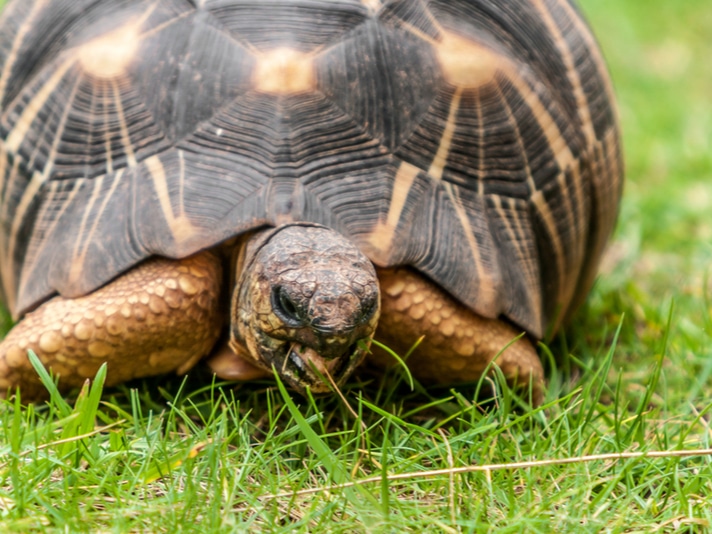Like other tortoises, radiateds need a high fiber diet with as much variety as possible.
Radiated Tortoise (Astrochelys radiata)
Radiated tortoises are found in Madagascar among the spiny forests and woodlands of Southern Madagascar. They have also been introduced to the Island of Reunion. A highly domed tortoise with beautiful radiating yellow/white lines contrasting over a jet black shell. Their skin is a dark yellow coloration, with a dark black marking on their blunted head. With elephantine feet, radiated tortoises make for an interesting species for tortoise keepers to care for and maintain. This species is endangered and captive breeding is tracked by the North American Studbook.
Availability
Depending on the time of year, radiated tortoises are available through individual breeders, and sometimes available at reptile shows throughout the U.S. During the spring months of March to June the "main" hatches happen. Radiated tortoises are known for being able to lay any month of the year and with the growing interest in this species by others they are now becoming more readily available in captivity.
Size
Radiated tortoises start off their life as small as a golf ball and will grow an average of two inches a year. Around 10-11 inches (plastron measurement) they will reach maturity and will top out between 12-16 inches. There is no size difference between the different genders of radiated tortoises. They all showcase a high domed shell and the radiated tortoises is considered to be one of the world's most beautiful tortoises.
Life Span
The oldest radiated tortoises ever recorded was Tu'i Malila, which died at an estimated age of 188 year old. Typically in captive environments radiated tortoises have shorter life spans, around 60-80 years. With being such long lived animals, tortoise caretakers should take that into consideration when considering taking on any tortoise.
Housing
Housing your radiated tortoises outdoors in a secured environment is ideal for this species. Of course this is when weather permits it. If temperatures reach 55 degrees or below, a heated home or an indoor tortoise table is needed. Keep in mind the larger the enclosure that is provided for the tortoise or tortoises, the more exercise they will be able to get. Planting edible landscape in the enclosure will offer them additional food options as well as different areas for them to retreat to, making them feel safe.
Lighting, Temperature, Humidity
Natural sunlight is the best thing for tortoises and should be offered whenever temperatures adiquite For hatchlings and younger tortoises being housed indoors, it is important to have a day and night cycle for them. Mercury vapor bulbs, which provide both UVA and UVB is the best light source that mimics the natural sunlight. During the evening when lights are turned off, a constant temperature should be maintained with a ceramic heat emitter bulb. A constant humidity around 50 percent should at least be maintained in the enclosure. This can be accomplished by keeping the substrate moist and occasionally misting the enclosure.
Substrate
There is many different substrates that work well for housing radiated tortoises on indoors. The two main factors when choosing a type of substrate are something that will retain moisture as well as provide a firm footing for the tortoise to gain strength as it walks. For example, a 50/50 mix of cypress mulch and organic top soil works very well. Substrates should be changed out and cleaned every few weeks to provide a clean environment for your tortoise.
Food
Like other tortoises, radiateds need a high fiber diet with as much variety as possible. They are grazers and will spend alot of the time during the day feeding. By planting a wide variety of edible plants in their environment, this will ensure the tortoises to have options for feeding throughout the day. A constant food plate of edibles should be offered as well. Calcium supplements in the form of cuttlebone are wonderful additions to their diet.
Water
Radiated tortoises are able to take in water though the food they eat throughout the day, but they still need a constant, clean water source available to them at all times. Tortoises are most active during or just after episodes of rain, and can be observed drinking from available puddles. Having an available mister system for captive radiated tortoises will provide a cool retreat for them.
Handling and Temperament
Radiated tortoises are a very hardy species that does well in captive environments. Even so, handling hatchlings and young radiated tortoises should be kept as minimal as possible. They can become over stressed by too much handling or by constantly changing their environment. With a routine of daily feeding, weekly cleaning and occational health checks, with time the tortoise will become very responsive to their keepers.
Reproduction and Breeding
Mature radiated tortoises are capable of breeding and laying clutches year round providing their environment and diet is correct. Around 12 inches in length males will pursue females with great interest, bobbing their head and smelling the female's hind legs and cloaca. Shortly after, the male will mount the female and start breeding. Females will construct a shallow nest will her hind legs and may lay 1-6 eggs per clutch. As females increase egg production as they mature, supplemental calcium in the form of cuttle-bones or calcium powder a good idea to supplement their diet with. This species does require a "diapause" in incubation for a more successful hatch. Average hatching time for clutches will happen between five and eight months depending on incubation temperatures.
Andrew Hermes is a tortoise enthusiast that maintains and cares for one of the most diverse tortoise breeding programs in the United States. www.arizonatortoisecompound.com was created to showcase and offer available offspring and knowledge to the general public.


